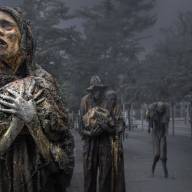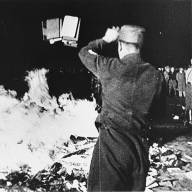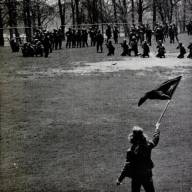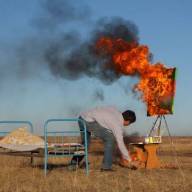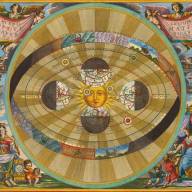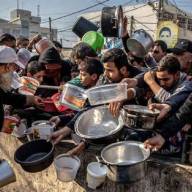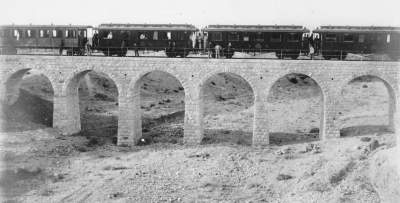Image from Imperial War Museum, public domain
Health is severely commodified and diseases are disgracefully exploited as means to social, political, and financial ends. Statements like, “Let us not play politics with people’s health” are made to dress up stealth politics and covert missions to play political games with people’s health and lives on behalf of some vested interest. It is done so by pretending the efforts are devoid of any politics and solely intended for the good of the general public.
In the current atmosphere of uncertainty, disinformation, and behind-the-scene jockeying around this maroon aureole, therefore, our priorities demand us to make transparent the underlying politics of top contenders in the competition of narratives. Who is doing what to whom, how, why, and what is next?
I borrow a passage from Sylvia Noble Tesh’s classic book (1988), Hidden Arguments: Political Ideology and Disease Prevention Policy,[1] to contextualize the point of this exercise and questions, The discussions in that book are a bit dated but their resonances feel rather current. She asserted:
“Behind debates about such questions as the toxicity of environmental pollutants, the hazards of smoking, and the health effects of cholesterol lie other hidden arguments. These arguments are more fundamental: What is the legitimate source of knowledge? What is the nature of human beings? And what is the ideal structure of society? Firmly but often unconsciously held answers to these questions guide scientists, policy makers, and ordinary citizens alike to different constellations of facts about the causes of disease and hence, to different preferences for prevention policy.”[2]
We could add questions about an infectious disease like COVID-19 and its potential causes to Tesh’s list and still be in the same frame of argument. It has been stated in the past and it does not hurt to repeat, as Shi’a, we do not believe there to be any separation between our politics and our religion. Health and diseases greatly affect if and how we perform our required and essential tasks like prayers, fasting, Hajj, jihad, and more. Even our most basic greeting, Salam, and the name of our religion, Islam, all share the same root as our word for health, Salamat. So, for us, there is no shame or any compulsion in admitting that matters related to health and diseases are one and the same as our religion and our politics.
Those societies in which their systems of beliefs have convinced their people, however, that health and disease decisions are made through some apolitical processes and free of political values should have followed Tesh’s advice some thirty years ago that,
“We need public discussion about the values, beliefs, and ideologies with which scientists and policy makers begin. This is not an unwarranted intrusion of politics into science. There is no science uninfluenced by politics. This is a plea to get the politics out of hiding.”[3]
Judging by the signs, I sense that the time for such public discussions by the elites are way passed their deadlines. Discussions about exactly whose political values, views, and interests in public health and diseases are hidden from the very public, at the exclusion of, and at the expense of that very public are all passed due. It appears in not so distant a future such discussions will be carried out by the public on the streets with guns and at gunpoint.
Meanwhile, it is useful to discuss and clarify a few relevant items since the decisions we make rest heavily on what we assume the causes of current events are. It is imperative to make the correct decision and determine which side to take and where to spend most of our energy. In this essay, I would like to discuss one of the Saker’s position regarding SARS-COV-2 and contrast that with the position of the Iranians.
From the beginning of the coronavirus affair, the Saker has maintained a firm position that novel coronavirus is not a bio-weapon. He made his point here and reiterated his position through multiple updates. He solidly sealed his view here. In a recent article here, he provided a reminder by recapitulating that “a truly weaponized virus would both be much more transmissible than SARS-COV-2 and it would be far more deadly.”
It is certainly quite appropriate to assume the null until we have enough solid evidence to reject it. That means, in the case of the novel coronavirus the default assumption would maintain the virus not to be a bio-weapon unless and until there is preponderance of reasonable evidence to reject the null assumption. The Saker has gone a step further, however. His statements, in effect, provide an acceptance of the null not as an assumption but as a proven statement.
The position of the Iranians contrasts with that position. It is not prudent for us to accept the Saker’s firm assessment and to rule out a strong possibility that SARS-COV-2 could be a bio-weapon. My own impetus to pry open the Saker’s stance is twofold. On one hand, I would like to ensure the principle of precaution in these discussions are not overlooked (i.e. the need to err on the side of caution). On the other hand, I think the actual rationale provided by the Saker concerning the aspects of “transmissibility” and “deadliness” of SAR-COV-2 in determining its weaponization status needs additional investigation.
First the principle of precaution. Iranians are a nation that has been the subject of relentless conventional and non-conventional attacks by the US and the west from every imaginable venue and by any conceivable means. Therefore, as a people who are still suffering from the consequences of the chemical attacks by then weaponized agent, Sadam Hussein, we do not feel we have the luxury of definitively accepting a non-weaponized status for this virus.
We imagine for ourselves four possible scenarios based on two rival assumptions. First, if we assumed this virus is a bioweapon and planned according to that assumption, and the virus turned out to have been indeed a bioweapon, then we have done right by our nation and what we are obligated to do in terms of preparation and protection.
Second, if we assumed the virus is not a bioweapon, thus we do not treat it as one but it is, in fact, a bioweapon, then we are guilty of neglect, carelessness, and in breach of our duties in protecting ourselves and our nation.
Third, if we assumed the virus is a bioweapon and prepared accordingly and it turned out not to have been one, then we have prepared for and put into practice a drill with all its required infrastructure that are useful for our defenses and preparedness. In addition, we have supported the country’s health system and have helped reduce its burden in dealing with an infectious disease.
Fourth, if we assumed the virus is not a bioweapon and it was not one, then we would have carried on with life as usual and dealt with a particularly tough flu season and we were no more prepared than before the whole affair.
The Leader of Iran, Ayatullah Khamenei clarified[4] Iran’s position and decision in one of his earlier speeches on March 8 as follows:
“Another key point is that we are asking all sections in the country, we request them to cooperate with a sense of responsibility with the Ministry of Health which is at the frontline of this issue and to make available to the ministry all their necessary resources. We have, of course, asked the armed forces and all organs linked to our office [i.e. the office of the Commander in Chief of all armed forces, Ayatullah Khamenei] that they, too, cooperate and put all of their resources in this area at the service of the people. This is not an event that has just happened for our country. You know and you have heard that this has happened in many countries of the world. The difference, of course, is that in many countries, they are hiding the truth, they are not talking about it. Our officials have spoken with sincerity and truthfulness from the very first day. They have been transparent in their reporting. They have made people aware of the situation which is a good thing. There are places though that we know they have it much worse than we do, but they do not talk about it. We do ask God Almighty for health and wellbeing for all those other countries, too. God Will InshAllah help them, too.
And the last word on this matter is that this event is a transient issue as well. It will pass. It is not an extraordinary event. Happenings similar to this occur in the country. Certainly, I do not wish to minimize the issue but we should not aggrandize it either. There is something that has happened. It will take a specific period of time. A period of time that will not be too long, InshAllah. This will exist for the country and then it will go away. The experiences that we will gain in this area, the actions that people take, and what various organs do, which in fact a general and a public drill in this area, this could become an achievement. If we could have these sorts of achievements, a calamity changes to a blessing. A threat changes into an opportunity.”
Last week, in an event held during this year’s Army Day celebration in Iran on Friday, April 17, Amir Sartip Aziz Nasirzadeh, the head of Islamic Republic’s Air Force, said[5],
“We view the spread of coronavirus through a military lens. The spread of this virus, in our calculation, is a biological threat or a quasi-biological threat. This subject for the armed forces of the Islamic Republic of Iran and the military is a practice and a drill to counter biological threats.”
For Iranians, therefore, to assume the novel coronavirus as a bioweapon is logically and wisely a more appropriate assumption. An assumption of otherwise could be more deleterious. However, the Iranians having figured into their calculus not to accept the null assumption about the novel coronavirus is not a reasonable evidence to reject the Saker’s argument. Therefore, I discuss the second element that motivates me to offer this rebuttal which relates to the actual rationale provided by the Saker. He used not high enough “transmissibility” and insufficient “deadliness” as two major determinants to reject the weaponization of SAR-COV-2.
To be fully transparent, I must say I am not an expert in weapons and my practical military training is limited to what a regular Basiji goes through here in Iran. That makes my expertise in this area limited to not accidentally shooting myself in the foot. My argument is therefore literary in essence and not based on practical skills and field experience.
To weaponize an agent (biological, chemical, or nuclear) and the degree of weaponization depends entirely on the specific aim and purpose for that weaponizing. That means, a biological agent can be designed and released to be not highly but “just enough” transmissible and not highly lethal but “just enough” deadly to achieve the intended goal of an attack. The US Center for Disease Control and Prevention (CDC) had identified around 30 organisms[6] that might be weaponized. CDC employs a classification scheme based on the intended outcome in three different categories of weaponizations for biological agents. The classification is based on “ease of dissemination, morbidity and mortality, panic potential, and level of public health requirements.” They have defined the categories as follows:
“Category A: Highest priority diseases that pose a risk to national security, are easily transmitted, have high morbidity and mortality, would have a major public health impact and cause panic, and require special public health preparedness.
Category B: Moderate priority diseases with lower morbidity and mortality and more difficult to disseminate.
Category C: High priority diseases that have the potential to cause significant morbidity and mortality and are emerging pathogens that could be engineered for mass dispersion. Category C agents are emerging pathogens that could be engineered for mass dissemination because of their availability, ease of production and dissemination, mortality rate, and ability to cause a substantial health impact.”[6]
It is therefore important to consider the intended outcomes as important variables in determining the weaponization of SAR-COV-2. Looking from this angle, transmissibility and deadliness would be more of a tactical decision commensurate to specific aims of the attack than key indicators of weaponization. It might be interesting to note that US CDC had classified SARS coronaviruses as potential biological agents under Category C[7], but it is now removed from its main page[8]. Those interested though could search for published scientific articles that used the CDC’s information as their references in earlier dates.
I would like to go a bit further in supporting my position. I will use an example of attack operations during World War I in which the British carried out “low-grade” attacks and acts of sabotage against the Ottoman’s darling project, the Hejaz Railway. An excerpt from an article by S. Anderson (2014) in the Smithsonian Magazine[9] illustrates the significance of the railroad:
“The southernmost town in Jordan, Mudowarra was once connected to the outside world by means of that railroad. One of the great civil-engineering projects of the early 20th century, the Hejaz Railway was an attempt by the Ottoman sultan to propel his empire into modernity and knit together his far-flung realm. By 1914, the only remaining gap in the line was located in the mountains of southern Turkey. When that tunneling work was finished, it would have been theoretically possible to travel from the Ottoman capital of Constantinople all the way to the Arabian city of Medina, 1,800 miles distant, without ever touching the ground. Instead, the Hejaz Railway fell victim to World War I. For nearly two years, British demolition teams, working with their Arab rebel allies, methodically attacked its bridges and isolated depots, quite rightly perceiving the railroad as the Achilles’ heel of the Ottoman enemy, the supply line linking its isolated garrisons to the Turkish heartland.”
Those attacks were carried out under the command of the British agent T.E. Lawrence (the infamous Lawrence of Arabia made famous by Hollywood). The attacks could have actually been more exact and more destructive than they were to finish the job of destroying the railroad in a much shorter time frame. However, they opted for operations that were less destructive. Lawrence himself explains the reason in Revolts in the Desert[10] by saying:
“In the drainage holes of the spandrils six small charges were inserted zigzag, and with their explosion all the arches were scientifically shattered; the demolition being a fine example of that finest sort which left the skeleton of its bridge intact indeed, but tottering, so that the repairing enemy had a first labour to destroy the wreck, before they could attempt to rebuild.”
“Scientifically shattered,” seems to suggest causing “just enough” destruction for the enemy to get entangled and locked in specific areas, to divert its resources, manpower, and focus to those areas and away from other priorities and critical tasks. If the bridges and the railroads of Hejaz Railway were “scientifically shattered” and tulip bombs were used to twist the rails into tangled ribbons of steel but not completely destroy them, why would not a virus be weaponized in a manner that can “scientifically shatter,” let’s say, health systems, health personnel, and infrastructure of a country with “just enough” but not very high destruction and lethality?
I can think of two specific reasons: 1) A fear that bioweapon would spread beyond the target population and adversely affect allies and own forces and populations. 2) A fear of God and the Day of Judgment. Let’s briefly explore both reasons. For the first one, in case the biological agent can make its way back to one’s own population, if the original source of the attack is prepared, then this becomes a non-issue. However, if not, we must examine whether or not those who use such weapons care sufficiently about their own people and populations.
In a study conducted by the Institute of Medicine titled, “Veterans at Risk: The Health Effects of Mustard Gas and Lewisite,” that was presented at a hearing by the members of the US Congress in 1993 regarding US Department of Defense Mustard Gas Testing,[11] it was revealed that 60,000 US service members were exposed to mustard agents and Lewisite during World War II. Based on the records of that hearing, participants in military test experienced varying degree of exposure to mustard agent or Lewisite. The tests ranged from a drop of agent on the arm in “patch” tests to repeated gas chamber trials and fields tests. In addition, there were thousands of non-service individuals who worked in the US arsenals that produced these chemical agents. There were no follow-up medical care or monitoring of long-term effects but at the time of hearing, the information from the study revealed that:

The scanned document is some hundred thirty pages long, within it though, there are some vivid descriptions that illustrate a high level of indifference and disregard for human suffering. An excerpt is shown below:

We could spend quite a bit of time to review similar examples from the exposure of Vietnam Veterans to Agent Orange[12, 13] to CIA and Military testing of LSD[14] to various DARPA projects. However, the point can be made that some governments’ concerns for health and wellbeing of their own people may not be sufficiently high to serve as an obstacle in decision making.
The second reason about why would a given power refrain from “scientifically shattering” populations and societies using bio-weapons is a fear of God and the Day of Judgment. It is that belief that we cannot really get away and there WILL come a day when we must defend our intentions and deeds. Here, I am not talking about a superficial belief and using the name of God Almighty as a political means to material ends. Nor am I speaking of the type of believers who think they can commit all sorts of atrocities and injustice and be forgiven by God because they are just so special and “chosen”.
وَقَالُوا لَنْ تَمَسَّنَا النَّارُ إِلا أَيَّامًا مَعْدُودَةً [And they say, “Never will the Fire touch us, except for a short period of time.” (Qur’ān, Chapter 2, Verse 80)].
I am speaking of genuinely true believers in God who are very fearful and weary of the day they must stand before their Creator and defend their actions. That is enough functional and practical (not theoretical) fear and weariness that would prevent them from violating God’s boundaries and committing atrocities now, here, and in this world.
Perhaps a passage from the book, Brother Qasem[15], which contains a collection of lectures, talks, and views from Martyr Sardar Soleimani could illustrate what I mean. The segment is titled “Didn’t you say you invited him?!” in the book:
“For years we had been chasing after one of the most notorious rebels in Sistan and Bluchestan. This rebel was very active in narcotic trafficking and had martyred great many of our revolutionary guard members. Finally, after employing very complex intelligence operations, we invited him to a special locality for negotiation. Immediately upon his and his companions’ arrival to the designated place, we arrested him and his team and put them in jail. We were very pleased. He was someone whose criminal record would have secured him some fifty death sentences.
In a meeting in which we were visiting the Leader [Ayatullah Khamenei], I brought up the subject and gave the Leader the news about the arrest and described the event. I was expecting to see a positive reaction and happy response from His Eminence. The Great Leader of the Revolution immediately ordered, “Tell them to set him free right this moment.”Without hesitation and question, I made the call. Afterwards, while quite baffled, I asked, “Agha! Why? I don’t understand; why did I have to do that? Why did you order his release?”
The Leader said, “Didn’t you say you had invited him?! The order of Islam is that if you invite anyone, and he is your guest, even if he is your father’s killer, you have no right to cause him discomfort.”I was stunned with the response. Immediately, of course, the Leader commanded, “You must make sure to arrest him.” A few months later, in another series of complex operations, we arrested the fellow.”
The rebel in question was Abdulmalik Rigi, the terrorist agent in the service of the US and the Saudis. But he is not the key point of the excerpt, the Taqwa (as operationalized here by the Leader of the Iranian Revolution) is. Taqwa is to always be mindful and fearful of God’s boundaries and to make sure one does not cross them not matter what the event or the situation. May peace be upon you.
References
[1] Tesh SN (1988). Hidden Arguments: Political Ideology and Disease Prevention Policy. 4th Edition, Rutgers University Press, New Brunswick, New Jersey.
[2] Ibid, P. 3.
[3] Ibid, P. 177.
[4] Speeches by Ayatullah Khamenei on Esfand 13, 1398 (March 8, 2020). Speech after Tree Planting Ceremony. Available online at: http://farsi.khamenei.ir/speech-content?id=45076
[5] Tasnim News Agency, “Fight against corona for armed forces is a military exercise against biological threats.” Farfardin 29 (April 17), 1399; 10:46; News code: 2245243; https://tn.ai/2245243
[6] Williams M, Sizemore DC. “Biologic, Chemical, and Radiation Terrorism Review.” [Updated 2020 Feb 17]. In: StatPearls [Internet]. Treasure Island (FL): StatPearls Publishing; 2020 Jan-. Available from: https://www.ncbi.nlm.nih.gov/books/NBK493217/
[7] Moran GJ (2002). “Threats in bioterrorism. II: CDC category B and C agents.” Emergency Medicine Clinics of North America, 20(2):311-30.
[8] US Center for Disease Control and Prevention (2020). Bioterrorism Agents and Diseases by Category. Access online at: https://emergency.cdc.gov/agent/agentlist-category.asp#c
[9] Anderson S (2014). “World War I: Hundred Years Later, The True Story of Lawrence of Arabia.” Simithsonian Magazine, Special Report, Available online at: https://www.smithsonianmag.com/history/true-story-lawrence-arabia-180951857/
[10] TE Lawrence (1926). Revolt in the Desert. Garden City Publishing Company, Inc.
[11] Hearing before the Sub-committee on Compensation, Pension, and Insurance of the Committee on Veteran’s Affairs, House of Representatives, One Hundred Second Congress, Second Session, March 10, 1993. Printed for the use of the Committee on Veteran’s Affairs, Serial No. 103-3. Available online at: https://ia802307.us.archive.org/31/items/departmentofdefe1993unit/departmentofdefe1993unit.pdf
[12] Hansen JC (1981). “The Vietnam Veteran vs Agent Orange: The War that Lingers.” Government Accounting Office (GAO) Review, Spring 1981, Pages 29-36. Available online at: https://www.gao.gov/assets/680/674041.pdf
[13] Stellman JM & Stellman SD (2018). “Agent Orange During the Vietnam War: The Lingering Issue of Its Civilian and Military Health Impact.” American Journal of Public Health, 108(6): 726-728.
[14] Disbennett BM (2014). “An Analysis of CIA and Military Testing of LSD on non-Consenting US Service Members and Recovery through the VA Disability System.” Tennessee Journal of Race, Gender, & Social Justice, 3(2): 173-201.
[15] Mehrvanfar A (1397). “Brother Qasem: a Collection of Strategic thinking of Haj Qasem Soleimani in areas of Guardianship, Revolution, Holy Defense, Martyrdom, the Protectors of Haram, Culture and Arts.” Mehr Amir-Al Mumenin Publishing, 1st Edition, Page 23. [Translated from the original in Farsi by the author.]

